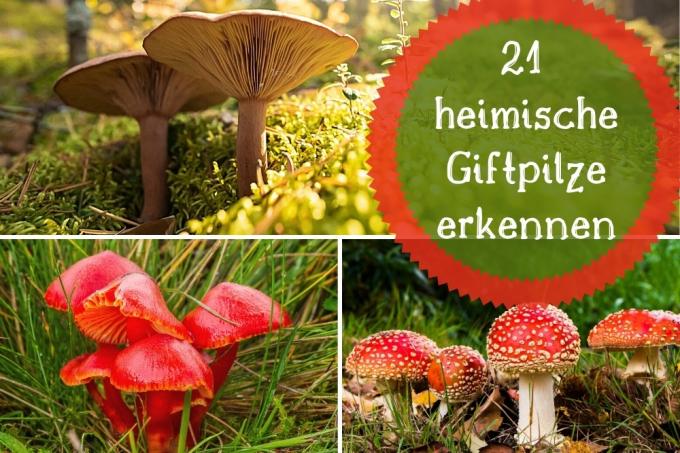
table of contents
- A to F
- G to K
- L to R
- S to Z
If you want to collect mushrooms yourself, you should be very familiar with it. This is especially true for detecting poisonous mushrooms. The most common native toadstools are listed here.
A to F
Broad-leaved turnip (Megacollybia platyphylla)

- Cap: 4 to 12 cm wide, color changeable from almost white to brown, cap skin dry, radially striated
- Stem: whitish or with a little hat color, glabrous
- Flesh: hat thin, light; The lamellae are bulging, distant, whitish to cream-colored, broad
- Occurrence: June to October, on rotten hardwood or softwood
- Toxicity: Consumption of large amounts of these mushrooms leads to nausea and vomiting
Spring poison lobster (Gyromitra esculenta)

- Hat: 3 to 12 cm wide, red-brown, brain-like convolutions, forms cavities
- Stem: light, short, pitted and wrinkled
- Flesh: brittle
- Odor: aromatic
- Occurrence: typical spring mushroom, March to May, sandy pine forest
- Confusion: with spring morels (hat deepened like a honeycomb, hollow throughout)
- Toxins: Gyromitrin, this toxic substance attacks the liver and kidneys, first symptoms after 4 to 8 hours
Tip: Since poison mushrooms are often difficult to identify, a mushroom advisor should be consulted in case of doubt. This sorts out poisonous mushrooms safely.
G to K
Yellow death cap mushroom (Amanita citrina)

In contrast to their relatives, these toadstools are not quite as dangerous, but they are more common.
- Hat: 4 to 10 cm wide, pale yellowish, yellow-greenish, rarely albino form, flat remains of the same color or tanned shell on the hat skin,
- Stem: white to pale yellow; hanging ring, bulb with a sharp, circumferential edge, rarely remains of the sheath visible
- Flesh: pale yellowish, browning on pressure; Lamellae white, dense, not grown
- Odor: like potato sprouts
- Occurrence July to November, coniferous and deciduous forest, sandy soil
- Tree partner: pine and spruce
- Risk of confusion: with other death cap mushrooms
- Toxins: Bufotenin, heat unstable, accelerates the heart
Common sulfur knight (Tricholoma sulphureum)

- Hat: 3 to 8 cm wide, sulfur yellow, mostly bald, dry, also silky
- Stalk: dyed like a hat, with darker fibers
- Meat: sulfur yellow; Lamellae grown on, thick, standing at a distance
- Odor: unpleasant, like carbide
- Occurrence: July to October, deciduous and coniferous forest, undemanding
- Confusion: green body (real knight, meat white, odor farinaceous)
- Toxins: The poisonous effect of these mushrooms is based on blood-dissolving substances that work mainly in the raw state.
Green-leaved sulfur head (Hypholoma fasciculare)

- Hat: 2 to 6 cm wide, yellowish, yellow-greenish, monochrome or darker in the middle
- Stem: pale yellowish, weakly overfibred
- Flesh: light; Lamellae yellowish green, brownish when ripe
- Taste: strongly bitter
- Occurrence: May to November, on dead wood of coniferous and deciduous trees, always in clusters
- Confusion: Smoky-leaved sulfur head (not bitter, maybe taste carefully)
- Toxins: Fasciculole, cause diarrhea and vomiting after about 30 minutes to 3 hours
Amanita phalloides, green and white amanita

Although these two poisonous mushrooms are well known, they often lead to poisoning because they are not recognized with certainty. The treacherous thing about death cap mushrooms is that the symptoms usually only appear hours after the meal, when the organ damage is already well advanced.
- Hat: 4 to 12 cm (exceptions up to 15 cm) wide, olive or yellow-green or white, mostly glabrous, with radial fibers, peelable cap skin
- Stem: whitish to greenish, often lumpy; Hanging ring, grooved on top
- Flesh: white, does not discolour; Slats remain white
- Base: lumpy, thick, white, membranous remnants of the shell (sheath)
- Smell: sweet
- Taste: mild
- Occurrence: June to October, deciduous and coniferous forest, parks, gardens, sometimes mass occurrences
- Tree partner: oaks and beeches
- Danger of confusion: pearl mushrooms and mushrooms (watch out for discolored meat or colored lamellae), deafblings and knightly lambs (brittle lamellae)
- Toxins: Amatoxins, destroy the liver, first symptoms are abdominal pain, vomiting and diarrhea, rescue usually only through liver transplantation
Carbolic mushroom (Agaricus xanthoderma)

The carbolic Egerling is the only common, poisonous mushroom species. If it cannot be determined with certainty, the error will be noticed at the latest when cooking, when the mushrooms turn yellow and the smell becomes very unpleasant.
- Hat: 4 to 15 cm wide, chalk white, sometimes also earth gray, top flattened
- Stem: white, slightly yellowish at the base, especially when pressed, with or without a tuber; Hanging ring, sharply demarcated
- Flesh: white, turning yellow on pressure or grated, cut stem base chrome-yellow; Slats pink or gray, close together, free
- Odor: like disinfectant or ink
- Taste: unpleasant
- Occurrence: May to October, deciduous and coniferous forest, gardens, parks, meadows
- Confusion: meadow or city mushroom (reddening meat), sheep mushroom (aniseed smell)
- Toxins: Toxic ingredients of various types can cause vomiting and diarrhea
Bald Krempling (Paxillus involutus)

These toadstools used to be considered edible. It is now known that the toxic active ingredients of these mushrooms have blood-dissolving and kidney-damaging effects.
- Hat: 4 to 15 cm wide, ocher to cinnamon brown, hunched when young, later flattened or with a depression, edge rolled up for a long time (carded, name!), Felty
- Stem: short, lighter than the hat, sometimes widening towards the top
- Flesh: lighter than the hat: ocher-colored lamellae, slightly sloping down, browning when pressed, crowded
- Smell: spicy, sour
- Taste: like smell
- Occurrence: July to October, deciduous and coniferous forest, parks, meadows
- Toxins: These poisonous mushrooms also contain muscarin and are therefore even more toxic in their raw state.
Potato Boviste (Scleroderma) – genus

With the exception of the pea sprinkler, which belongs to the same genus, all species are poisonous. Consumption of large quantities causes nausea and vomiting.
- Fruiting body: tuberous, 2 to 10 cm in size, from a distance quite similar to a potato, also in the color and the texture of the "bark", yellow-brownish, beige, grayish
- Stalk: only very short, almost completely without
- Flesh: outer layer a few millimeters thick, depending on the type, dark inside, gray to blackish, when the spores ripen the outer skin breaks open and releases the blackish spores
- Odor: pungent metallic
- Occurrence: June to October, deciduous and coniferous forest, parks, rarely on other green areas
L to R
Softwood Häubling (Galerina marginata), Poison Häubling

This poisonous mushroom can easily be mistaken for the edible and popular stick sponge.
- Hat: 1 to 5 cm wide, ocher to reddish brown, amber-colored, often two-colored, shape hemispherical, flat or bell-shaped, hat skin usually bare, slightly translucent and sticky when wet
- Stem: colored like the hat, later darker, ringed, pale overfibred below
- Flesh: yellowish to dark brown; Lamellae yellowish to rust-brownish, grown or slightly sloping, crowded, narrow
- Odor: ground like flour, also like rotting wood
- Occurrence: September to November, mainly on old coniferous stumps, but also on hardwood, gregarious
- Danger of confusion: stick sponges (handle below the ring dark, fungal odor), smoky-leaved sulfur head (lamellae gray)
- Toxins: like death cap mushroom
Note: Since all of the above mushrooms can lead to fatal poisoning, tasting is strongly discouraged. Poisonous mushrooms are generally not recognizable by their taste.
Panther mushroom (Amanita pantherina)

- Hat: 4 to 10 cm wide, light or dark brown, edge not grooved, pure white remains of velum on the hat skin
- Stem: white; Narrow ring, not grooved on top, bulb with a raised rim (so-called mountaineering socks)
- Flesh: white; Slats close together
- Odor: radish-like
- Occurrence: July to November, deciduous and coniferous forest, sandy soil
- Danger of confusion: pearl mushrooms (ring grooved, flesh reddish in color) or gray amanita (ring grooved), neither of which has mountaineering socks
- Toxins: similar to fly agaric, these toadstools cause what is known as pantherina syndrome
Porphyry brown amanita (Amanita porphyria)

- Hat: 4 to 8 cm wide, porphyry brown, violet-gray remains of velum on the hat skin, edge not rubbed
- Stem: pale with a bit of hat color, lightly ruffled, ringed, tuber with a sharp edge, rarely visible remains of the sheath
- Flesh: pale, free-standing lamellae, crowded, whitish
- Odor: like potato sprouts
- Occurrence: June to October, mainly coniferous forest, but also deciduous forest, acidic to calcareous soils
- Tree partner: spruce and beech
- Danger of confusion: pearl mushrooms (ring grooved on top, flesh reddish in color), gray amanita (ring grooved, odor like radish or beet)
- Toxins: see yellow death cap mushroom
Rancid funnelling (Clitocybe phaeophthalma)

- Hat: 2 to 7 cm wide, dirty whitish or pale horn-colored, gray-brownish, deepened in the middle
- Stalk: colored similar to hat, base overgrown by mycelium like cotton wool
- Flesh: colored like a hat; Slats running down, rather thick
- Odor: unpleasant rancid-sweetish
- Taste: bitter
- Occurrence: September to November, deciduous forest
- Tree partner: European beech, oak
- Toxins: These poisonous mushrooms contain the neurotoxin muscarin. After 15 minutes up to 4 hours it leads to sweats, visual disturbances, vomiting and gastrointestinal cramps.
Crack fungi (inocybe)–genus

- Hat: mostly dry, conical to bell-shaped, often flattening with age, tearing radially (name!), Color light whitish, light and dark brown to pink or brick red (brick red crack fungus)
- Stalk: colored like a hat, longitudinally fibrous
- Flesh: whitish when young, often tinged red when injured or in old age, lamellae grown, grayish or dirty brown
- Often slightly fruity odor, not unpleasant
- Occurrence: May to October, deciduous or coniferous forest
- Tree partners: European beech, oak, spruce, hazel
- Toxins: Toadstools of this genus contain similarly toxic substances as the poisonous funnellings.
Note: Almost all crack fungi are poisonous, the few edible species should be avoided because of the risk of confusion.
Red and brown toadstool (Amanita muscaria resp. A. regalis, synonym: king's fly agaric)
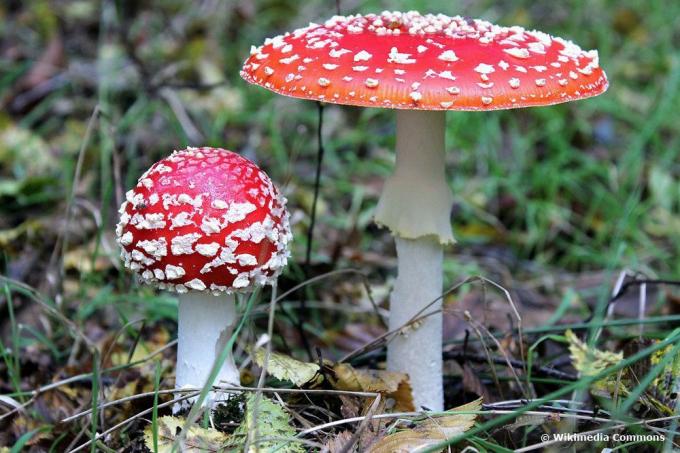
The toadstool of these species are well known and the red toadstool is as good as distinctive. The only exception is the still closed youth stage, then the mushrooms should be cut through. Toadstools have a clearly recognizable orange-yellow to greenish line under the cap skin.
- Hat: 5 to 15 cm wide, brightly red or brown in color, typical white remains of velum on the hat skin, grooved on the edge
- Stem: white, tuber without sheath, but with wreaths; Ring not rubbed on top
- Flesh: white; Lamellae densely packed, bulbous, free
- Odor: insignificant
- Occurrence: August to November, deciduous and coniferous forest, gardens, parks, very sociable
- Tree partner: birch and spruce
- Danger of confusion: Brown toadstools can be confused with perl mushrooms (reddish discolouration of meat) or gray amanita (odor like radish)
- Toxins: ibotenic acid, muscazone, muscimol, act on the nervous system; Consumption of these poisonous mushrooms causes confusion, shortness of breath, speech disorders, fatigue, nausea, vomiting, diarrhea after 30 minutes up to 2 hours
S to Z
Juices (Hygrocybe)- genus

- Hat: mostly small, 1 to 5 cm wide, exceptions up to 10 cm, very colorful, orange, red, yellow or greenish, glassy, greasy or dry depending on the weather
- Stem: mostly colored like a hat, longitudinally fibrous, blackening with age, becoming slimy when wet
- Flesh: yellowish or orange to red, old turns black, fragile; Lamellae standing at a distance, ascending or descending, tacked on, rather thick
- Occurrence: June to October, damp meadows, forest edges, parks
- Toxicity: With the exception of a gray-colored species, all other saplings are at least slightly poisonous.
The consumption of these poison mushrooms causes indigestion up to and including vomiting and diarrhea.
Satan's boletus (Boletus satanas)
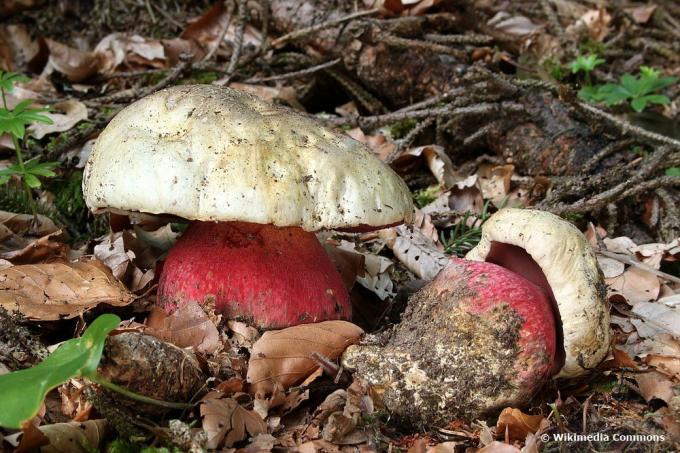
There are few poison mushrooms among the boletus. Two of them are presented here. They can be confused with other tubulars, which also have a red stem.
- Hat: 8 to 25 cm wide, chalk white, greyish, yellowish discolouration where the snails have eaten fresh, dull, dry
- Stem: reddish or yellow with a reddish base, reticulated
- Flesh: whitish to yellowish, slightly blue on pressure; Tubes bright red, more yellowish with age
- Smell: sweet and fruity, later carrion-like
- Taste: mild
- Occurrence: July to October, deciduous forest, limestone soils
- Tree partners: oaks, beeches
- Danger of confusion: witch bonsons
- Toxicity: The mushrooms cause gastrointestinal problems.
Boletus calopus
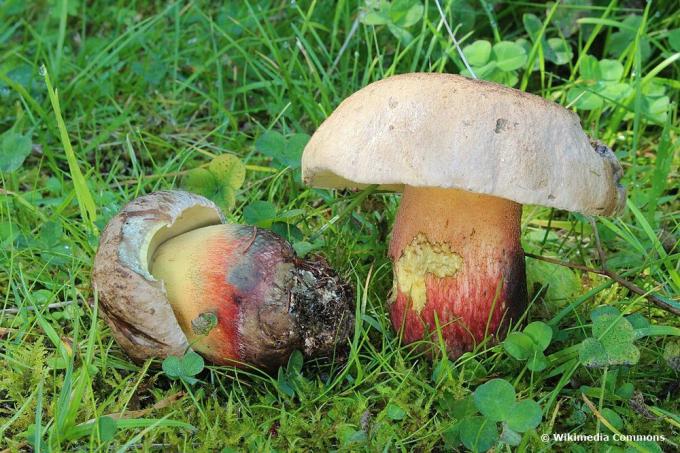
- Hat: 5 to 18 cm wide, dirty whitish, light gray, light brown, gray brown, matt, dry
- Stem: reddish, yellow in the upper area, reticulated
- Flesh: whitish to yellowish, tapering blue-green when cut; Tubes lemon yellow, later olive yellow
- Taste: bitter
- Occurrence: July to October, deciduous and coniferous forest, acidic soils
- Tree partner: spruce, red beech
- Toxicity: This mushroom is inedible due to its bitterness; raw it causes gastrointestinal problems.
Soap Knight (Tricholoma saponaceum)

- Hat: 4 to 10 cm wide, color changeable from light to dark, also yellowish-green or greenish, always light brim, smooth, bald, not smeary
- Stem: lighter than the hat, longitudinally fibrous or scaly
- Flesh: light, reddening after a while; Lamellae thick, distant, grown on
- Smell: if these poisonous mushrooms lie for a long time after soapy water
- Taste: unpleasant, possibly flour-like
- Occurrence: September to November, deciduous and coniferous forest, undemanding
- Confusion: with other knights (without reddening meat and soap odor)
- Toxins: similarly toxic effects as sulfur knight
Pointed Rough Head (Cortinarius rubellus)
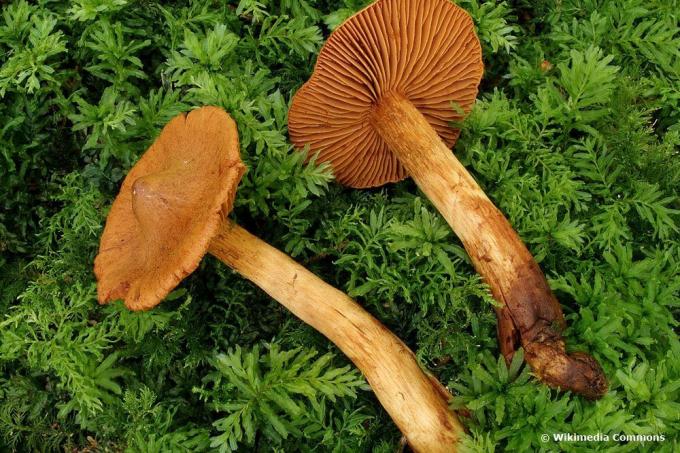
- Hat: 3 to 8 cm wide, orange-brownish, rust- or cinnamon-orange, colorful appearance, thin-fleshed, pointed or rounded in the middle (name!), Hat skin finely felted or scabbed
- Stalk: color like hat, lightly pimped
- Flesh: yellowish to rust-brown; Lamellae standing away, plump
- Odor: slightly radish-like
- Occurrence: August to October, coniferous forest, acidic soils, in peat moss, sociable
- Tree partner: spruces
- Risk of confusion: especially with other rock heads, all of which, however, are not edible.
- Toxins: Orellanins, can cause fatal kidney failure
Waxy, Lead whiter and Rinnigbereifter funnelling (Clitocybe candicans, C. phyllophila, C. rivulosa)

These mushrooms are so similar that they can easily be confused with one another. All three types are toadstools.
- Hat: 1 to 8 cm wide, whitish to flesh-colored when young, frosted, later blotchy, often flat, funnel only hinted at
- Stem: whitish, base often overgrown by mycelium
- Flesh: whitish to flesh-colored; The lamellae are straight or sloping, only white, later, flesh-colored
- Odor: sweet-sour
- Taste: mild
- Occurrence: August to November, rarely also December, deciduous and coniferous forest, parks, field edges, meadows, sometimes form witch rings
- Confusion: larger specimens can be confused with red chalk knights
- Toxins: toxic effect similar to rancid funnel
Brick-red sulfur head (Hypholoma sublateritium)

- Hat: 3 to 10 cm wide, brick-red especially in the middle, lighter on the outside, yellowish, the edge covered with flakes of velum
- Stem: light, whitish to yellowish, base rather brownish
- Flesh: light; Lamellae gray-green, with age olive-brown
- Taste: bitter
- Occurrence: August to November, in clumps on hardwood stumps
- Toxins: The toxic effect is based on the same ingredients as the green-leaved sulfur head.
